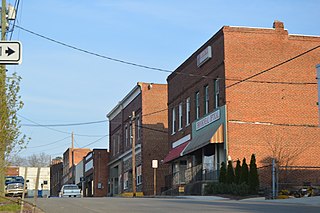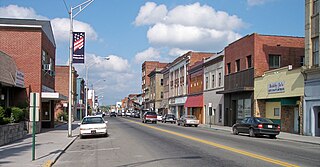
Altavista is an incorporated town in Campbell County, Virginia, United States. The population was 3,450 at the 2010 census. It is part of the Lynchburg Metropolitan Statistical Area.

Brookneal is an incorporated town in Campbell County, Virginia, United States. The population was 1,112 as of the 2010 census. It is part of the Lynchburg Metropolitan Statistical Area.

Victoria is an incorporated town in Lunenburg County, Virginia, United States. The population was 1,725 at the 2010 census, which was down from the 1,821 reported in 2000.

Pocahontas is a town in Tazewell County, Virginia, United States. It was named for Chief Powhatan's daughter, Pocahontas, who lived in the 17th-century Jamestown Settlement. The town was founded as a company mining town by the Southwest Virginia Improvement Company in 1881. It was the first company mining town in Virginia. The post office opened on June 30, 1882.

Princeton, is a city in and the county seat of Mercer County, West Virginia, United States. The population was 5,872 at the 2020 census. It is part of the Bluefield micropolitan area. The city hosts the Princeton WhistlePigs baseball club of the Appalachian League.

Mullens is a city in Wyoming County, West Virginia. The population was 1,475 at the time of the 2020 census. It is home to a highly rated railroad themed restaurant "Second Street", and has a railroad crossing at the front entry of the town.

Henry Huttleston Rogers was an American industrialist and financier. He made his fortune in the oil refining business, becoming a leader at Standard Oil. He also played a major role in numerous corporations and business enterprises in the gas industry, copper, and railroads. He became a close friend of Mark Twain.

The Virginian Railway was a Class I railroad located in Virginia and West Virginia in the United States. The VGN was created to transport high quality "smokeless" bituminous coal from southern West Virginia to port at Hampton Roads.

The Norfolk and Western Railway, commonly called the N&W, was a US class I railroad, formed by more than 200 railroad mergers between 1838 and 1982. It was headquartered in Roanoke, Virginia, for most of its existence. Its motto was "Precision Transportation"; it had a variety of nicknames, including "King Coal" and "British Railway of America". In 1986, N&W merged with Southern Railway to form today’s Norfolk Southern Railway.

William Nelson Page was an American civil engineer and industrialist. He was active in the Virginias following the U.S. Civil War. Page was widely known as a metallurgical expert by other industry leaders and investors as well as state and federal authorities.
The Deepwater Railway was an intrastate short line railroad located in West Virginia in the United States which operated from 1898 to 1907.
The Tidewater Railway was formed in 1904 as an intrastate railroad in Virginia, in the United States, by William N. Page, a civil engineer and entrepreneur, and his silent partner, millionaire industrialist Henry Huttleston Rogers of Standard Oil fame. It was put together with the intention of creating an outlet to Hampton Roads, where coal mined along their older West Virginia short-line railroad, the Deepwater Railway, could be exported.

Frederick James Kimball was a civil engineer. He was an early president of the Norfolk and Western Railway and helped develop the Pocahontas coalfields in Virginia and West Virginia.
Walters is an unincorporated community in Isle of Wight County in the Hampton Roads region of southeastern Virginia in the United States. The elevation is 56 feet (17 m).
Pageton is a census-designated place (CDP) in McDowell County, West Virginia, United States. As of the 2010 census, its population was 187. Pageton is located on the Tug Fork Branch of the Norfolk and Western Railway, along the Pocahontas seam of rich bituminous coal. Pageton is located on State Route 161 between Thorpe and Anawalt.
The Winding Gulf Coalfield is located in western Raleigh County and eastern Wyoming County, in southern West Virginia. It is named after the Winding Gulf stream, a tributary of the Guyandotte River. In the early 20th century, it was promoted as the "Billion Dollar Coalfield".

Pocahontas Coalfield, which is also known as the Flat Top-Pocahontas Coalfield, is located in Mercer County/McDowell County, West Virginia and Tazewell County, Virginia. The earliest mining of coal in the coalfield was in Pocahontas, Virginia in 1883 at Pocahontas Mine No. 1, now on the National Register of Historic Places.
The Kanawha and Pocahontas Railroad Company was incorporated in West Virginia in 1898 by either a son or the estate of Charles Pratt to reach new coal mining territory on land which was owned and/or leased by Gallego Coal & Land Company, Charles Pratt and Company, and other investors based in New York City.
The Princeton–Deepwater District is a rail line in West Virginia that connects Deep Water, West Virginia, on the Kanawha River southwards to Princeton, West Virginia, and beyond to rail lines leading to Virginia. It is known for its rugged terrain and opportunities for rail photography.














